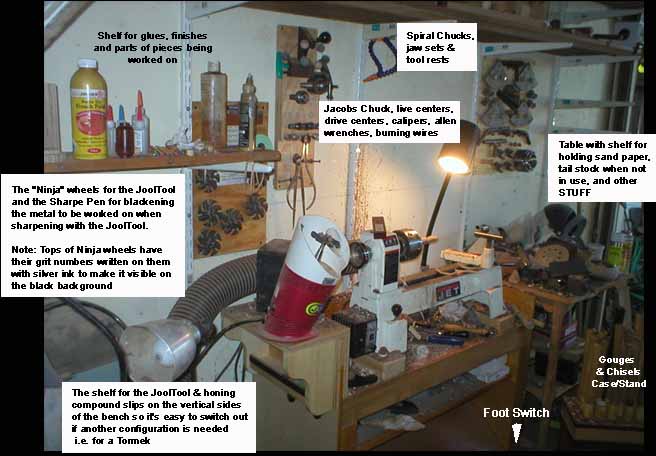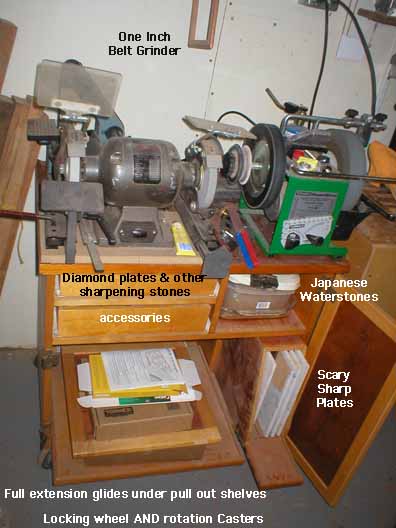So let's recap the list of What's So Good About The Jool Tool.
Here's the Jool Tool - in my shop context.
As you can see, it has a pretty small footprint - that's a little electric heater behind it. ALL it's accessories are on that piece of ply behind and above it - screwed to the wall - "ninjas" on 1/4" dowels - and the What Grit Is What Color chart in the middle.
As you can see, it doesn't take up much room at all. I built a little shelf, with another littler shelf underneath, that can slip over either end of my shop made lathe bench. If, while turning on my little JET variable speed mini/midi, I need to touch up an edge I can take a half step left, flip the switch on the Jool Tool and be back to turning in 30 seconds - or less.

Now compare that to this - my sharpening station cabinet (with drawers). So when I say Small Foot Print - I mean it.

The only assembling required is driving two screws to secure this thing to a piece of ply. OK - so I also had to peel the backing of the little ninza shaped abrassive things and stick them to the flat underside of the little black plastic things that look like ninja throwing stars - but that's it. No heavy lifting, no pages of assembly instructions, no dozen or two little parts to try and not lose.
You may also have noticed that there are no special jigs or fixture to deal with. If you know how to trace a picture - then you can sharpen just about any edged tool you own - or may own. Take a black Sharpi pen, blacken the bevel you want to sharpen and come up from below the spinning "ninja" - which by the way - you can see through when it's spinning - and sharpen off everything that is black. When it's gone you lower the tool away from the spinning thing - and you're done. You do have to be careful not to "catch an edge" on the spinning abrassive - and that takes a little extra caution on initial contact - but you quickly pick up the technique.
Oh - if you're sharpening curved gouges or carving tools - there's a slick little bristle brush wheel that takes off the "wire" after sharpening the bevel - AND - polishes the inside face of the tool at the same time. Quick and easy.
Notice that there are no tools - no wrenches, no screw driver, no tools at all to change "ninjas" Twist one off and spin the next one on - everything is "finger tight".
Want to crank the RPMs up to polish an edge with the felt wheel and poishing compound? Turn the speed control to the right (clockwise) and go up to whatever you want - the max is 5000 RPMs. Not comfortable sharpening at 5K RPMs? Then turn the speed dial down (counter clockwise) until you find a speed you are comfortable with.
Now I know I'm the only person who has ever "burned an edge"while attempting to sharpen it. Not a problem with the Jool Tool. The fan blade effect of the spinning "ninjas" takes care of some of the heat build up thing - and it's only a 3" diameter thing that's spinning so the feet per second is not high enough to generate enough heat to destroy the temper in the steel.
Now about the mess other sharpening methods create - grinders and belt sanders generate a lot of "dust", the Tormek needs water and your tool and bench top get wet, india and arkansas stones use messy oil, japanese waterstones and Scary Sharp ain't exactly non-messy either and diamond plates, like sharpening stones need a lubricant too. There is no mess with the Jool Tool. If you have a lot of metal to remove, either from a single tool or because you "batch" sharpen, you can hook up a shop vac type hose to this thing and any potential mess gets sucked away.
Like everything else, there is a down side (OH BOY - HERE IT COMES!).
The price tag may cause some folks a bit of Sticker Shock - "This thing is almost all plastic (actually the important parts are steel with precision bearings - stuff that really counts) - and it's so small and light. $350 seems like a lot to pay for what looks like a toy!" (Consider what a bench grinder PLUS two wheels PLUS a "jig system" comes to. Now price four stones, japanese water stones or oil stones. Check out the price of the Tormek - with what they call "accessories" and you soon discover are "necessities". Now think of what this thing can do and then compare price to performance)
The "consumables" are proprietary - and not "inexpensive" - about $20 to $30 a pop. Those little black plastic throwing star things that you stick the abrassive to - $20 each - and you need one for each "grit" you plan on using since the Peel And Stick abrassives can't be removed without damaging them. Need more abrassive thingees? They're about $3 a piece, sold in Six Packs.
The one thing the Jool Tool doesn't do very well is - flatten the back of plane irons - especially the wide japanese "irons" or the wider Stanley / Hock plane irons. Fortunately, you only have to flatten them ONCE.
MY CONCLUSIONS ABOUT THE JOOL TOOL
I'd buy it again. Being able to touch up and edge quickly, or doing a little regrinding of an edge without any mess - while seeing what is being ground is worth the bucks. Your mileage may vary.
If you have any questions that aren't answered on the Jool Tool website or have comments, suggestions or constructive criticism of this information - e-mail me